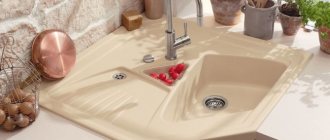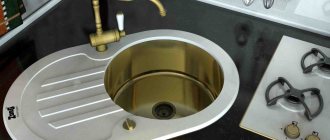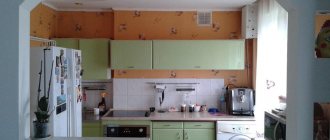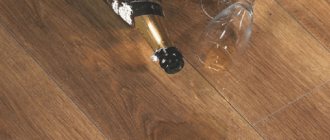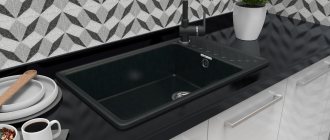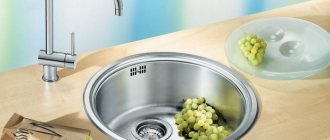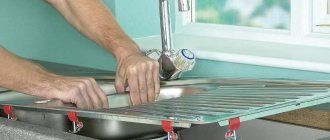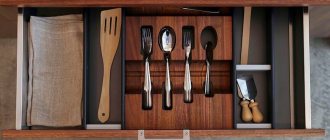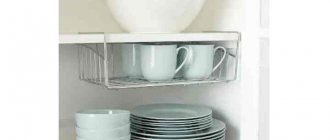The corner location of the sink can often be found in small kitchens. Sometimes this is the only possible solution that allows you to fit everything you need in the work area. But is a corner sink always convenient to use? How to choose the right place for it so that washing dishes does not turn into hell? We will show specific examples of options for convenient and inconvenient locations.
Reviews on forums from those who have already installed a sink in the corner are very mixed.
There is almost an equal number of those who are “for” and those who are “against” such an arrangement. Both of them present their arguments. We have presented some of them in the table below.
| pros | Minuses |
| No space is wasted on the countertop. There is still room for a work surface. The cabinet under the sink is a convenient place to store a trash can and cleaning supplies. | Surprisingly, other housewives see this as a minus. · It is inconvenient to use a cupboard and drying rack in the corner. · Instead of a sink, you can install large household appliances - a toaster, coffee machine, microwave, etc. · Instead of communications, you can install a “smart” corner with rotating or retractable sections. If there is a siphon and drain pipes, then the space will not be used so rationally. |
| Compact round with or without wing, ideal for corner placement | The large sink doesn't fit. The round one is not always convenient for everyone: for example, it is impractical for washing a baking sheet from the oven. |
If you choose from the point of view of saving storage space, then everything is very individual and depends on how you are used to and can organize your closets. But the question is how convenient it is to wash dishes while standing in the corner will depend on several factors:
- bowl shape;
- overall shell dimensions;
- rotation angle;
- choosing the right installation location.
There are L-shaped kitchens with a corner cabinet in the shape of a trapezoid. In this case, you can embed a sink of any shape.
But in some cases, a right angle looks much prettier than a beveled one, so let’s consider options when you don’t have to sacrifice either aesthetics or convenience.
See also our large selection of beautiful kitchens with a corner sink - see.
Standard kitchen sink sizes
Everyone's preferences are different, so there is a wide range of sizes to choose from. Small bowls are convenient for washing small cutlery, such as tea saucers or cups (you can’t fit a lot of dishes at once).
There are also large products from 80 cm in length. They are convenient for washing large dishes or for defrosting a hefty piece of meat.
The choice depends on food preferences and the presence or absence of a dishwasher.
The standard dimensions of a kitchen sink are 55-60 cm wide and 50-55 cm deep. At the bowl, it varies from 16 to 19 cm. They are convenient when washing forks, spoons, vegetables and cleaning them.
If you prefer to cook dishes that require bulky utensils, then your choice of kitchen sink bowl size will depend on the size of the largest baking sheet or frying pan in your home. A traditional small kitchen sink measures 45 cm wide.
Cabinet and tabletop size
Firstly, the bowl cannot be larger than the cabinet. A smaller size is allowed, but not a larger one.
To choose the right size sink, you need to have 2 measurements:
- Width of the cabinet frame.
- All measurements of the area where you plan to place the sink (if it has a drain). For ease of use, you need to take into account the fact of who you are - right-handed or left-handed? The wing should be located on the corresponding side.
To ensure that when choosing kitchen sinks, they have the appropriate dimensions for the cabinet, you need to follow some general tips:
- Do not allow the sides to press tightly against the wall. You need to leave a gap of 5 cm. Example: the frame of the cabinet is 50 cm wide, which means it is possible to install a sink 45 cm wide (the size of the wing is not taken into account).
- Do not allow the sink to be adjacent to the outer edge of the countertop by more than 5 cm. That is, there is no need to place it close (in size) to the cabinets. Otherwise, while washing dishes, water splashes will fly onto clothes and the floor. But you also don’t need to install it very far away, otherwise it will be inconvenient.
- An overhead kitchen sink (if the choice fell on it) should have dimensions corresponding to the dimensions of the cabinet (example: the cabinet should be 60x60 cm and the sink should be 60x60 cm).
Bowl depth
Some tips for choosing depth:
- The optimal depth of the bowl is 16-19 cm. It is capacious and does not allow water to splash. This is the volume most products have.
- Sinks with a depth of more than 20 cm are good when you constantly use large containers or baking trays. For domestic use, this is not the best idea, since your back will be strained every time. But this can be corrected by raising the cabinet higher.
- Shallow bowls (less than 16 cm) are only good in bathrooms. Because when washing dishes, water splashes will scatter onto clothes, the floor and the countertop.
- If the sink has a diameter of less than 45 cm, then its depth, in most cases, reaches 20 cm or more.
Number of sink bowls
The number of bowls can be completely different. There are sinks with one, two and three sections. Sinks with more than 1 section are especially good and practical: in the first section you can wash dishes, and in the next one you can rinse them. If the kitchen space allows you to place a larger sink (with 2 or 3 sections), then it is better to install just this one, because using these is much more convenient.
To install multi-section sinks, you need a cabinet frame at least 80 cm wide. This is usually required for sinks with 2-3 bowls. Or you can install such a sink on a corner.
If the space is neither large nor small, then one-and-a-half sinks are suitable. Their length starts from 60 cm. That is, there are 2 bowls, just one of them is 2 times smaller than the first.
Number of bowls
The number of bowls is selected depending on the size of the kitchen and the requirements of the housewife:
- a single-bowl sink is the classic and most popular option, suitable for small kitchens as it takes up minimal space;
- double bowl sink allows you to organize your work process more productively. In one bowl, for example, you can soak vegetables or herbs, defrost meat, and use the second for washing dishes. Trapezoidal sinks are usually equipped with two bowls. The bowls can be the same or vary in size. Alas, it is almost impossible to use such a solution in a small kitchen;
- sink with three or more bowls (up to five) - a privilege for owners of large kitchens. This is an option for avid cooks who constantly wash, soak, rinse, and defrost something. The range of such sinks is not so large, and the prices are higher than for models with one or two bowls.
Types of kitchen sinks
Decide where you would like to install the sink: is there room for it on a straight part of the countertop or would it be more convenient for you to use it in a corner? Let's look at the main types.
Direct
The kitchen cabinet under the sink, which has a straight design, has the following dimensions in length: 60-80 cm with two doors; 30-40 cm with one door. Suitable for spacious rooms.
Straight cabinets with sinks are easy to use due to the ease of access to them (unlike some corner models). But oversized cabinets are convenient when there are special drawers. Without them, it is difficult to get the things you need.
Large cabinets are made from oak or beech because they are the most durable.
Corner
The corner kitchen cabinet for the sink has standard dimensions or is made to order. This version of the cabinet is good for placing kitchen appliances, detergents or a water heating system on it.
Standard dimensions of a corner sink Corner planning solutions for the kitchen are rightfully considered the most ergonomic and functional. Largely thanks to the underlying triangle rule.
It is when this is observed that the housewife spends less time and effort walking along the work surface. The corner cabinet under the sink is traditional for Russian kitchens and rarely does anyone decide to abandon it. After all, it is from the corner that all water supply and drainage systems are connected. And transferring them is quite labor-intensive and not always justified.
https://youtube.com/watch?v=YJiuw9q8uFI
Types of corner cabinets:
- Straight side corner table. In fact, it is a standard kitchen module with one “muffled” door - a false panel. The most common option in modular kitchens.
- L-shaped corner table-pedestal. The most flexible option in terms of resizing. Most often it is equipped with a transforming door, which significantly expands access to the inside of the cabinet.
- Trapezoidal table-pedestal for sink. The most bulky “classic” version of a corner cabinet under the sink. It is not recommended to install it in small kitchens, as it “eats up” a lot of usable space.
The sizes of the corner sink in the kitchen set are different, because there are sinks with an acute angle and with a beveled one.
The first option is distinguished by the presence of two doors. From the outside, such a cabinet looks like 2 single drawers, but when you open the doors, you get one large drawer with shelves. The dimensions of the corner sink kitchen cabinets are as follows: corner – 87 x 87 cm; side shelf depth – 44 cm; height – 81.5 cm.
Corner sinks with a beveled corner are larger than the previous ones, but in fact more convenient. Their parameters: angle – 85 x 85 cm; shelf depth – 60 cm. To simplify cleaning, legs are included in the package (their length is 10 cm).
Invoice
This type replaces the tabletop. The format matches the cabinets. In addition to the sink, the package also includes separate areas for installing a faucet.
One of the varieties of the overhead system is a sink with an extensive wing. It connects to the main tabletop. This arrangement of the corner is cumbersome in appearance, but every single millimeter of space is used to advantage.
But this type is imperfect, since water will be poured into the joints between the parts of the kitchen unit. Accordingly, the furniture will quickly deteriorate.
Mortise invoice
For installation in the tabletop, you need to make holes in accordance with the dimensions of a certain model. The frame or wing should fit onto the table and rise up. The main thing is to perform high-quality processing of the docking points.
For installation in the tabletop, you need to make holes in accordance with the dimensions of a specific model
Mortise
Built-in kitchen sinks have different dimensions: they are not located above the countertop, but, on the contrary, go deeper inside. This type is expensive, and the installation process is difficult and long, since there are different sizes, and countertops for undermount kitchen sinks are mostly made of artificial stone.
Step-by-step instructions for installing a corner sink
We will give instructions for installing a round stainless steel sink Ø 51 cm, steel thickness 0.8 mm. These sizes are considered average in all respects. In the kit you need to buy a siphon, a complete set of gaskets and fasteners for installation. Immediately pay attention to the diameter of the siphon and sink tubes; they must be the same and connected with a clamping nut.
Sink with siphon (set)
Step 1
. Install a siphon on the sink. This is done in several stages.
- Unpack all the elements of the siphon and check that they are complete. Carefully study the functions of each part according to the instructions. Unpacked sink, bottom view
- Screw the funnel to the sink, do not forget to install rubber gaskets on both sides. Tighten the nut tightly, but do not use wrenches; hand force is sufficient. If you tighten it too much, the plastic may not withstand significant internal stress and may crack. Leaks will definitely appear, and the siphon parts will have to be changed. Funnel screwed on
- Screw the siphon sump to the outlet of the tube. First you need to remove the nut from it and put the oil seal in place. Siphon sump
- Attach the flexible corrugated overflow hose. It drains excess water from the sink into the drain and prevents the room from flooding. Flexible corrugated overflow hose
The hose is connected to the overflow hole
Check the connections, everything is fine - proceed to installing the sink on the countertop.
Step 2
. Place the sink upside down on the countertop. Move it to a place where it will be permanently attached.
Step 3
.
Draw a circle with a regular pencil. Make sure that the sink remains motionless at all times and does not slide on the surface of the countertop. Do not press too hard with the pencil; the line will then be wiped off. Use a pencil to draw a circle
Drawing circle
Step 4
.Step back from the circle about 1.5 cm; the side of the sink will rest on this edge.
The specific size needs to be removed from the sink, we give an approximate value. You need to step back one and a half or two centimeters so that the sink rests on the countertop with its edge.
Mark the hole in the countertop about 0.5 cm larger than the measured diameter, this will greatly simplify the installation process.
The fact is that cutting a perfect circle in a tabletop with ordinary tools is very difficult; differences can reach several millimeters. Such differences will not allow the sink to be inserted into the countertop; the hole will have to be adjusted to size several times. This takes a lot of time - adjustment is done only by hand using sandpaper.
Step 5
. Along the perimeter of the outlined circle, place points for the inner circle. The more there are, the easier and more accurate it is to then draw the second circle. Connect the marks together, you should get an approximately even circle. We have already told you that by increasing it, it will be possible to level out small errors during marking.
The distance is plotted along the ruler
Circle drawn according to markings
Step 6
. Drill holes in the tabletop with a diameter of approximately 10 mm, this is necessary for the first lowering of the electric jigsaw saw. The hole must be made on the line of a circle of smaller diameter.
Drilling a Hole
Step 7
. Using a jigsaw, carefully cut out a circle in the tabletop. Try the sink on, it should fit without jamming.
Cutting out a circle with a jigsaw The cut circle can be removed
Step 8
. Replace the rubber seal around the perimeter of the sink on the back side. It has one side with a strong adhesive applied, remove the protective paper strip from it and carefully glue it. Do not allow folds or kinks to appear; water will get through them and damage the countertop.
Fasteners and seal Installation of rubber seal and clamps
Step 9
. Cut off the excess piece. Try on the sink.
Trying on a sink. If everything is perfect, you can connect the siphon to the drain and install a mixer
Video - Inserting a sink into a countertop
Practical advice. If the tabletop is made of laminated chipboard, we strongly recommend carefully lubricating the cut along the entire perimeter of the hole with a high-quality sealant; it will reliably protect the material from moisture penetration.
Chipboard reacts very negatively to moisture, and it will definitely get under the sink; no rubber rings will help. Over time, the slab will swell and then completely lose its original load-bearing characteristics. Such problems cannot be eliminated by repair; you will have to redo the entire countertop.
Step 10
. Reattach the drain pipe. One end of it is put on and tightly screwed onto the siphon, and the other is inserted into the sewer pipe. Before this, a tee of the appropriate diameter must already be installed on it.
Bottle siphon assembly diagram Siphon diagram for a double sink with the ability to connect household appliances
Video - Assembling a siphon for washing
All that remains is to fix and connect the mixer; it must be purchased separately. If you carefully follow the recommendations, the sink will serve well for many years.
Installation diagram of a kitchen faucet with drinking water tap
Video - Installing a kitchen faucet
Important. Don't forget to attach the sink to the countertop on the back side. There are special devices included for this purpose.
Attaching the sink to the countertop from below
Check the strength of the sink's fixation; it should not wobble; apply considerable force around the perimeter. It is better to detect and eliminate problems before operation begins than to eliminate the consequences of emergency situations later.
The article will help you choose the best option for a corner sink for the kitchen, correctly combining its dimensions with the dimensions of the room and the linear parameters of the furniture. This is very important when planning a furniture set. On the pages of our website there is a very interesting article with professional advice on choosing corner kitchens. Read it, this knowledge will help you avoid many mistakes when selecting furniture for the kitchen.
Types of designs: shape and dimensions
The shape of the sink influences its choice, since it must match the style of the kitchen, be comfortable, functional, and spacious. And this is a description of different forms, since the assessment of these parameters is individual for everyone.
Round
The most convenient round kitchen sink measures 45-60 cm in diameter and 16-20 cm in depth. This option is good for small kitchens. Round sinks look neat and laconic.
It is not recommended to purchase a sink that is too shallow or too deep. Because of the first, when used, you and everyone around will be in the water, and because of the second, back pain will be guaranteed.
Oval
Oval sinks are models with a wing. They are presented in formats from 56 to 78 cm (length) and from 44 to 51 cm (width).
The oval shape has many advantages:
- Convenient to wash dishes of any size (both large and small).
- Compactness.
- Dirt will not collect in the corners, since there are none.
- Variety of materials.
- Fits into any interior.
Square and rectangular
These are classics, but due to the use of new materials and manufacturing technologies, square and rectangular sinks fit well into the Art Nouveau style.
Among the parameters, the following are popular: 50 x 60; 60 x 60; 80 x 60; 100 x 60; 120 x 60 cm.
Trapezoidal
Traditional sizes: 90-112 cm (larger side), 40-70 cm (smaller side). The corner part of the kitchen unit for the sink should have dimensions of 90 x 90 cm.
The front of a trapezoidal sink is either concave or straight. You should not make the bedside table small, as the presence of small doors will complicate use.
Other forms
If you don’t like the usual forms, then you can do something unconventional. As a rule, this is done when there is no space at all or the concept of the room requires informal solutions.
The triangular sink is installed directly into the corner part of the set. It takes up minimal space. And if a non-standard shape is included in the kitchen concept, then they can order any shape, for example, a crescent-shaped sink.
Furniture under the corner sink
A corner cabinet can accommodate a huge amount of kitchen utensils, appliances and other household items, but this is subject to proper organization of the space and convenient access to it. Ergonomics largely depends on how the door under the corner cabinet is made:
- beveled door - the most popular option. The corner part of the tabletop has a rectangular shape, in front it has a bevel at an angle of 45 degrees, the door is equipped with a swing mechanism. Despite the widespread use of this solution, it cannot be called the most convenient, since the dimensions of the door are much smaller than the space of the cabinet - difficulties may arise with access to the most remote areas;
- a radius door is no different from a beveled door, but it looks more interesting;
- with two doors that swing open to the sides or fold like an accordion. In order to open the corner cabinet, you will need to use more space in front of it, but you will get maximum access to all parts of the cabinet.
The organization of the internal space depends on what you are going to store in the corner cabinet. If there are several trash cans there for separate waste collection, then you won’t have to come up with anything. But if you plan to use this part of the set for storing pots, detergents, etc., then the following ideas may be useful to you:
- a roll-out mechanism facilitates access to the entire space of the corner cabinet;
- shelves can be made rotating;
- On the door you can organize a storage system of hooks and small shelves.
Due to communications under the sink, minor difficulties may arise when arranging storage areas.
Recommendations and life hacks for choosing a kitchen sink
- To choose the right size of kitchen sinks, consider the cooking habits of your family - how often you wash dishes, how much you cook, and so on. For example, if the kitchen is small and the family is not large, then choose kitchen sinks with a width of 45 cm;
- Additionally, you can choose a small sink if your kitchen has a dishwasher. However, the depth of the sink should allow large pots and baking trays to be rinsed in it;
- Pay attention not only to the length, width, depth, but also to the thickness of the material and the height of the sides. A mortise sink with higher sides will be more practical, and the thickness of the stainless steel – the thicker the better (acceptable thickness of stainless steel is 1.2 mm or more);
- Much depends on the type of mixer chosen. For example, if you want a faucet built into the countertop, then the size of the sink should be selected taking into account the space for it;
- The standard sizes of cabinets are from 60 to 35 cm. Of course, it is important to first install the cabinet, and then select a sink for it;
- And one more thing - if your set does not have room for a three-section spacious sink, then use a faucet equipped with a pull-out “shower”.
Examples of location and design: photo design and video of sink installation
The size of the sink depends on various factors: shape, type, number of bowls, etc. When choosing, you need to pay attention to all aspects. The main thing is to choose one that is convenient for use. There are no objective assessments here, since comfort is understood differently for everyone.
What is the rationale for choosing a model?
Taking advantage of the space in the corner is an advantage of efficient space organization, where a small room will benefit. Successful placement of furniture in this area guarantees the formation of a spacious space.
Installing a kitchen set with a corner sink is a winning solution, since in this option it will be possible to use a voluminous cabinet for storing things, as well as the empty space of the corner area on the countertop.
Experienced housewives skillfully involve even the section of wall between the sink and the upper tier of cabinets into work. Here you can place a dish dryer, shelves for household chemicals and other necessary little things.
Using a corner to install a sink provides a choice of any type of sanitary ware. Sinks with this location are produced from all available materials.
The configuration, despite the modest dimensions of the room, can be chosen to suit your preferences. Even a product with several bowls will be placed without harming the usable space (which is unacceptable with a linear arrangement of containers) of a small room.
The corner sink in the kitchen is easy to use - the location does not limit movement, adjacent surfaces become accessible, and it becomes possible to correctly organize ergonomics.
Main types
Showing interest in sinks, many wonder what options there are in terms of shape and material of manufacture. Sinks with corner orientation are distinguished by a variety of configurations; variations with this arrangement can be made from standard materials and various shapes.
Material of manufacture
Common materials for the manufacture of plumbing products for the kitchen are:
- stainless steel;
- granite (natural, artificial);
- metal coated with enamel;
- ceramics.
Stainless steels are popular. The material is easy to work with, which is why manufacturers present a wide range of models. The sinks are resistant to temperature changes, household chemicals, and do not require complex maintenance.
Disadvantages of products made from this material: noise, accumulation of lime and soap deposits, instability to mechanical damage.
Over the past few years, buyers have shown increased interest in stone products. Granite corner sinks have many positive qualities. The products are not afraid of mechanical, temperature, chemical influences, are able to absorb noise, and retain their original appearance for a long time. These qualities are characteristic of objects made of natural stone and a mixture of composite and acrylic. But artificial granite requires careful handling.
Steel or cast iron coated with enamel has long been used in the manufacture of plumbing products. It is not often possible to find corner sinks made of these materials in a modern interpretation on sale. The products are not distinguished by their presentable appearance. But the sinks are durable, reliable, and have most of the standard advantages.
The disadvantage of the products is their high susceptibility to scratches, chips, and, after time, corrosion.
A corner sink in a kitchen is rare, but it can be made of ceramics. This material is more typical for bathroom plumbing. The products are highly environmentally friendly, resistant to mechanical damage, and have good noise insulation. Among the disadvantages is the weight of the products, which entails difficulties during installation and is not the lowest cost.
Shapes of corner sinks
A corner sink in a kitchen can have any shape. The most commonly used variations are:
- square;
- round;
- rectangular;
- triangular;
- oval.
The square shape is considered popular; sinks with such a bowl do not take up much space, so they are often used in small spaces.
Round shapes are less spacious, but convenient to use. Such bowls are compact, so they are preferable for small rooms.
Rectangular containers are similar to square ones, but are very bulky. Such options are chosen to expand the functionality of the product (use additional features).
The main bowl is rarely triangular or oval in shape; often such containers are additional. But an entire corner kitchen sink is often made based on these shapes.
Functionality
The dimensions of the sink are selected based on the parameters of the room and personal preferences. It is logical that the wider the bowl, the more convenient it is to work with it. Products with a single container have the most acceptable values of this parameter.
The depth of the bowl is also an important parameter. Small containers are fraught with excessive wetting of the nearby area. Very deep - guarantee increased load when working with it.
The number of bowls is no less important to ensure the proper functionality of the item. The more compartments a sink has, the more practical it is. Each section can be used for different purposes at the same time. The work process will go faster and more efficiently.
The existence of additional devices (cutting boards, food racks, dish dryers) helps improve actions. Any kitchen will benefit from the presence of technical innovations. The sink in the corner of a small kitchen especially needs them.
Material of manufacture
The operational and aesthetic properties of the sink depend on the material from which it is made. The following solutions are popular:
- Stainless steel sinks are distinguished by their low price and a solid set of advantages . They withstand high temperatures well, are not afraid of impacts, are easy to care for and durable. The steel can be matte, glossy, semi-gloss and even patterned, so the sink can easily fit into any interior style. The main disadvantage of steel sinks is the noise when water falls from the tap. To reduce discomfort, it is better to choose a sink made of thicker steel. Connoisseurs of silence can pay attention to products with rubber layers. In operation, sinks with a matte surface perform best, since on a glossy surface scratches and traces of water drops become more noticeable;
- A sink made of artificial stone will decorate any kitchen. Such products are made using slightly different technologies, but the general principle is the same - a binder (usually acrylic resins, up to 20%) and dyes are added to the stone chips (up to 80%). The result is a product that is visually indistinguishable from natural stone. The variety of colors and patterns is huge; any natural stone can be imitated. In addition to aesthetics, the advantages of composite sinks include absolute noiselessness, strength, resistance to high temperatures, ease of maintenance, durability and maintainability (scratches can be polished). Artificial stone does not conduct electricity, and in the kitchen, where there are a lot of household appliances, this is important. The main disadvantage is the high price. It is also worth considering the decent weight of the product (this is the load on the tabletop). Resistance to high temperatures depends on the quality of the product: good sinks can withstand 2800C without any problems, but bad ones cannot withstand temperature changes (they are even afraid of food coloring). No matter how expensive and high-quality the sink is, very hot objects should be placed on its surface with great care - white marks may remain;
Sinks made of artificial stone GranFest Domestic sinks made of artificial stone GranFest have proven themselves to be excellent. On the company’s website https://granfest.ru you can see the widest range of GranFest and EWIGSTEIN sinks. The catalog presents models in various colors with one and two bowls and a wing. You can find the optimal solution for kitchens of different sizes, decorated in different interior styles. Suitable mixers, dispensers, grinders and other accessories are also available. The high quality of products is confirmed by compliance with all European and domestic standards
- Ceramic sinks are an option for those who do not like standard solutions. Ceramics have proven themselves to be resistant to high temperatures, scratches, excellent appearance, hygiene and ease of care. Such a sink will not make noise, even with a strong flow of water. But why have such products never gained much popularity? It's all about their fairly large weight and tenderness. If a more or less heavy object falls onto the sink (and in the kitchen the probability of such an outcome is high), the product may crack, and then it will have to be completely replaced - repairs in this case will be impossible. Plus, such sinks are not cheap;
- Enameled sinks are used less and less. Today, this solution is more likely for those who want to create an interior in a retro style than for those who value the special performance qualities of such products. However, enamel sinks are not short of practicality. The product is a bowl made of steel or cast iron, coated with a thick layer of protective enamel, which protects the metal from corrosion and makes the product more aesthetically pleasing. Enameled sinks are inexpensive, easy to clean, durable, resistant to high temperatures, durable, and due to the many shades of enamel, the sink can fit into any interior style. The products have almost completely left modern kitchens due to low mechanical strength - chips and cracks may occur when pans and pots are dropped. Traces of food coloring may remain on the enamel, but with normal care it will be possible to maintain the surface in its original form for a long time. Please note that not all products are suitable for cleaning such a sink - metal brushes and acidic detergents can damage the enamel. Like stainless steel sinks, enameled ones make decent noise when water falls;
- A wooden sink is a rare beast in the kitchen. Yes, this product looks more than solid. There will be no noise when water falls, the material itself is durable, and scratches can be easily polished, but the sink will need regular maintenance. A tree that is exposed to water and temperature changes every day will quickly become covered with cracks and mold without special means. Is it worth talking about the high price of such sinks? A wooden sink is an option for kitchens where cooking is done infrequently, and it is not the practicality of the material that comes to the fore, but its aesthetics;
- A sink made of natural stone is very beautiful and very expensive. The advantages of the solution include high strength, resistance to moisture and temperature changes. No amount of impact will damage the surface of the sink, but many performance characteristics depend on the type of stone. Granite, for example, is an example of strength, and marble, due to its high porosity, can become colored over time by food coloring. In addition, a stone sink weighs a fair amount, which will significantly complicate installation.
Advantages and disadvantages of corner models
Kitchens with a corner sink are rated as more functional. This is due to a number of advantages inherent in a sink located at the junction of the walls.
The main ones:
- significant space savings;
- expansion of space in the corner;
- increasing the convenience of operations;
- wide selection of types of sinks.
Due to these criteria, it is advisable to install the sink in an empty corner. In this case, a ready-made kitchen set with a corner sink is most preferable. This way you don’t have to worry about the parameters of objects or fixing the sink. The corner sink in the kitchen with the cabinet should be correctly combined. Therefore, when selecting each item separately, it is necessary to take into account many nuances.
Among the disadvantages of corner structures are often identified:
- smaller bowl size than linear modifications;
- complicating the use of cabinets adjacent to the sink;
- deterioration of the situation with maintaining the cleanliness of the corner.
The nature of the arrangement does not allow combining large bowls. These will be either 2 equal small containers, or 1 larger and the other smaller. Therefore, it is better to prefer a single model.
The approach to the sink is not convenient when using adjacent cabinets at the same time. Open doors block space and prevent free access. This is true when 2-3 people work in the kitchen at a time.
If you need to reach distant objects in the corner, you will have to use additional devices. The same goes for cleaning this space.
Which headset will be most comfortable?
The most common kitchen layout is corner. Placing a sink in the corner of the kitchen in this case means functional use of the space. Use a pentagonal (beveled) model as a cabinet under the sink - it will be more convenient to approach the water.
To place a sink in the corner of the kitchen, only a corner set is not necessarily suitable. In a single-row (straight) or parallel arrangement, the corner is also present in the form of an abutment to the wall. True, using a sink located here will be inconvenient, especially if the wall is on the side of the leading hand.
The last option is a U-shaped layout. In this case, it is better to move the wet zone out of the corner, because in this case there are much more opportunities and the conditions allow it. Otherwise, the rules are the same as for corner furniture. 2 ways to form a work triangle in the kitchen with the letter P:
- Sink on the lintel, refrigerator on one side, stove on the other.
- Sink in the corner, refrigerator on one side, stove on the lintel. The third part is reserved for the dining table or consists of high columns.
In small kitchens, install a corner set: thanks to the sink between the rows, you can save valuable space on the countertop.
Features of choice
When choosing a suitable model, you need to pay attention to the material from which the product is made. Both technical characteristics and the nature of care, appearance of the item, and compliance with the environment depend on the choice.
The next important aspect is the device configuration. Ease of use of the model is the main factor when choosing. For some, a single bowl is enough, while others find it impossible to make do with a limited variation. The same applies to the location of containers, the presence of a wing, and additional devices.
When choosing a sink separately from the set, you need to thoroughly study the dimensions of each item. Incorrectly selected parameters can cause a lot of inconvenience during installation.
You need to think about the installation option of the selected model in advance. In this case, the capabilities of the sink and cabinet must be taken into account. Not every tabletop material is suitable for installing a mortise model, and not all bowls can be placed in an overlay manner.
